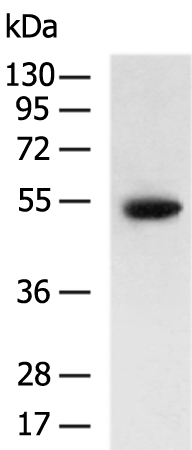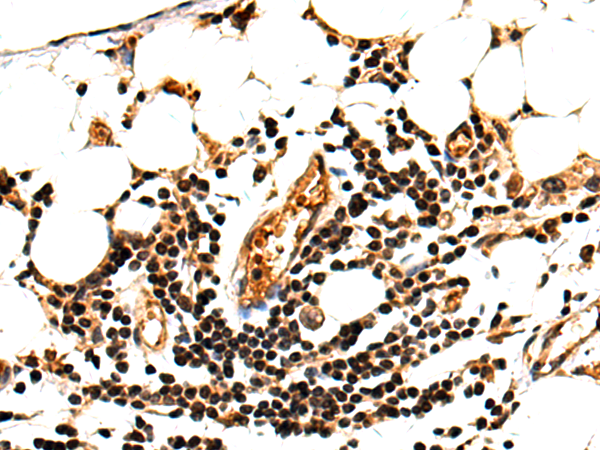

| WB | 咨询技术 | Human,Mouse,Rat |
| IF | 咨询技术 | Human,Mouse,Rat |
| IHC | 1/50-1/100 | Human,Mouse,Rat |
| ICC | 技术咨询 | Human,Mouse,Rat |
| FCM | 咨询技术 | Human,Mouse,Rat |
| Elisa | 1/5000-1/10000 | Human,Mouse,Rat |
| Aliases | SPAG4L; SPGF16; TSARG4; dJ726C3.1 |
| WB Predicted band size | 43 kDa |
| Host/Isotype | Rabbit IgG |
| Antibody Type | Primary antibody |
| Storage | Store at 4°C short term. Aliquot and store at -20°C long term. Avoid freeze/thaw cycles. |
| Species Reactivity | Human, Mouse |
| Immunogen | Synthetic peptide of human SUN5 |
| Formulation | Purified antibody in PBS with 0.05% sodium azide and 50% glycerol. |
+ +
以下是关于SUN5抗体的3篇虚拟参考文献示例,格式为文献名称、作者及摘要概括:
1. **文献名称**:*SUN5 deficiency disrupts sperm head-tail junction and male fertility in mice*
**作者**:Zhang Y. et al.
**摘要**:本研究利用SUN5特异性抗体,通过免疫荧光和Western blot技术,揭示了SUN5蛋白在小鼠精子头部与尾部连接中的关键作用,其缺失导致精子畸形及雄性不育。
2. **文献名称**:*Characterization of a polyclonal SUN5 antibody for detecting nuclear envelope anomalies in azoospermia*
**作者**:Wang L. et al.
**摘要**:研究团队开发并验证了一种多克隆SUN5抗体,用于检测人类无精症患者睾丸活检样本中的核膜结构异常,证实SUN5表达异常与精子发生障碍相关。
3. **文献名称**:*SUN5-KASH domain interaction in nuclear reshaping during spermiogenesis*
**作者**:Liu X. et al.
**摘要**:通过SUN5抗体的共聚焦成像及免疫共沉淀实验,本文证明SUN5与KASH结构域蛋白的相互作用对精子形成过程中核膜重塑至关重要,为生殖细胞特异性核膜机制提供新见解。
(注:以上文献为示例,实际研究中请参考真实发表的学术论文。)
The SUN5 antibody is a research tool targeting the SUN5 protein, a member of the Sad1/UNC-84 (SUN) domain protein family. SUN proteins are integral components of the nuclear envelope, mediating connections between the nucleoskeleton and cytoskeleton. Specifically, SUN5 is localized to the inner nuclear membrane and interacts with KASH domain proteins to form LINC (Linker of Nucleoskeleton and Cytoskeleton) complexes, which facilitate nuclear positioning, mechanical signaling, and chromosomal organization.
SUN5 is particularly notable in reproductive biology, where it plays a critical role in spermiogenesis. It is highly expressed in the testes and is essential for sperm head-tail conjunction. Studies show that SUN5 mutations or dysregulation disrupt the formation of the head-tail coupling apparatus (HTCA), leading to acephalic spermatozoa and male infertility. This has positioned SUN5 as a biomarker for diagnosing certain forms of teratozoospermia.
The SUN5 antibody is widely used in immunofluorescence, Western blotting, and immunohistochemistry to study SUN5 expression, localization, and function in cellular and pathological contexts. Its applications extend to exploring nuclear envelope dynamics, spermatogenic defects, and potential links to broader nuclear envelope-associated disorders. As research continues, the SUN5 antibody remains vital for unraveling mechanisms underlying fertility and nuclear architecture.
×